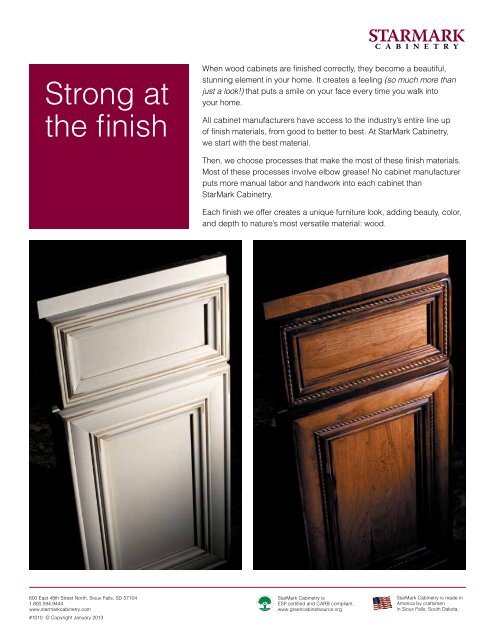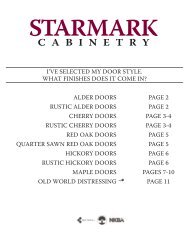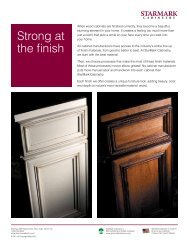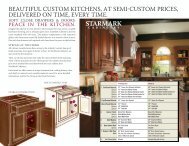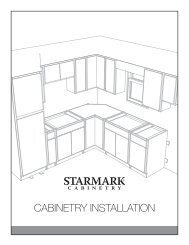Printable information sheet on StarMark Cabinetry's finishing process
Printable information sheet on StarMark Cabinetry's finishing process
Printable information sheet on StarMark Cabinetry's finishing process
You also want an ePaper? Increase the reach of your titles
YUMPU automatically turns print PDFs into web optimized ePapers that Google loves.
Str<strong>on</strong>g at<br />
the finish<br />
When wood cabinets are finished correctly, they become a beautiful,<br />
stunning element in your home. It creates a feeling (so much more than<br />
just a look!) that puts a smile <strong>on</strong> your face every time you walk into<br />
your home.<br />
All cabinet manufacturers have access to the industry’s entire line up<br />
of finish materials, from good to better to best. At <strong>StarMark</strong> Cabinetry,<br />
we start with the best material.<br />
Then, we choose <strong>process</strong>es that make the most of these finish materials.<br />
Most of these <strong>process</strong>es involve elbow grease! No cabinet manufacturer<br />
puts more manual labor and handwork into each cabinet than<br />
<strong>StarMark</strong> Cabinetry.<br />
Each finish we offer creates a unique furniture look, adding beauty, color,<br />
and depth to nature’s most versatile material: wood.<br />
600 East 48th Street North, Sioux Falls, SD 57104<br />
1.800.594.9444<br />
www.starmarkcabinetry.com<br />
#1010 © Copyright January 2013<br />
<strong>StarMark</strong> Cabinetry is<br />
ESP certified and CARB compliant.<br />
www.greencabinetsource.org<br />
<strong>StarMark</strong> Cabinetry is made in<br />
America by craftsmen<br />
in Sioux Falls, South Dakota.
Finishes<br />
Stain<br />
A stain is a basic finish that adds color to wood while revealing<br />
the beauty of the grain. The same stain looks different <strong>on</strong> each<br />
specie. <strong>StarMark</strong> Cabinetry species are Alder, Rustic Alder,<br />
Cherry, Rustic Cherry, Hickory, Rustic Hickory, Lyptus, Maple,<br />
Oak and Quarter Sawn Oak.<br />
For the richest, most c<strong>on</strong>sistent color coverage, we apply the<br />
stain and then hand rub it into the wood. There are no machine<br />
shortcuts: elbow grease is the <strong>on</strong>ly way to coax the luster from<br />
stained wood.<br />
Tinted Varnish<br />
The best way to describe Tinted Varnish is to say it gives<br />
cabinetry a paint-like finish. Throughout the country, this type of<br />
finish is also called “enamel” or “opaque”. We use Tinted Varnish<br />
<strong>on</strong> maple and oak cabinetry, and each specie yields a different<br />
look. The grain of maple wood is c<strong>on</strong>cealed by Tinted Varnish,<br />
while the grain of oak shows through Tinted Varnish.<br />
Glaze<br />
Glaze adds depth to stain and Tinted Varnish. The profiles <strong>on</strong> a<br />
door, moulding, corbels and other details <strong>on</strong> cabinetry, such as<br />
rosettes, shells or a fleur-de-lis, are stunning when glazed. The<br />
best way to glaze Yes, more handwork. We apply a wet glaze<br />
by hand and then wipe it off by hand. This handwork helps the<br />
glaze settle into the open grain areas. Also, when a craftsman<br />
wipes off the glaze, he or she can best use the glaze to define<br />
the details in that particular kitchen.<br />
Other cabinet manufactures are satisfied with shortcuts: using<br />
a dry glaze, applying the glaze with a brush, or even faking the<br />
look with markers. We take pride in handcrafting every<br />
comp<strong>on</strong>ent—door, drawer, moulding, panels—that goes into<br />
your kitchen.<br />
We currently have six glazes: Br<strong>on</strong>ze, Chocolate, Eb<strong>on</strong>y, Nickel,<br />
Latté and Vanilla.<br />
DISTRESSING<br />
So a stain, a Tinted Varnish and a glaze will put color<br />
<strong>on</strong> your cabinetry. You can go further and add patina<br />
to the cabinetry.<br />
For instance, a maple door finished in White Tinted<br />
Varnish with Chocolate glaze can receive the Cottage<br />
treatment, resulting in worn edges and rounded corners.<br />
We also have Amaretto, Bordeaux, Chateaux, Linen,<br />
Oatmeal, Villa, Old World Distressing, and à la carte<br />
distressing. All characteristics, for example, worm holes,<br />
rasping, knife marks, are added by hand. There is no<br />
machine and there is no robot that can successfully<br />
duplicate what the eyes and hands of an artisan<br />
achieve through pers<strong>on</strong>al handling of the cabinetry.<br />
The Process<br />
Depending <strong>on</strong> the finish you choose, your cabinetry may go<br />
through 8, 10 or 14 steps in our factory so we can lay down the<br />
most beautiful, smooth and durable finish possible. “Baking” a<br />
finish is necessary to achieve the most durable finish, so all of<br />
our finishes require the cabinetry comp<strong>on</strong>ent to go through our<br />
industrial oven at least twice.<br />
More important than the number of steps in our finish <strong>process</strong> are<br />
our employees. We have inspectors at every step, including the<br />
final step, to ensure quality. All employees are empowered to pull<br />
any comp<strong>on</strong>ent off the line if it does not meet their standards.<br />
Terminology<br />
Catalyzati<strong>on</strong><br />
<strong>StarMark</strong> Cabinetry’s finishes are Catalyzed C<strong>on</strong>versi<strong>on</strong> Varnishes.<br />
When the acidic catalyst is mixed with the sealer or topcoat, it<br />
causes them to cure (dry). Without a catalyst, the sealer and top<br />
coat would be sticky. The oven baked cure gives the finish even<br />
more durability.<br />
Seal Sanding<br />
Seal sanding gives wood a scratch pattern so the top coat will<br />
stick to the sealer. It creates a mechanical b<strong>on</strong>d between the<br />
sealer and top coat. Sanding also smooths the sealer and knocks<br />
down any raised fibers. This helps the top coat lay flat. The end<br />
result is the smoothest finish possible. At <strong>StarMark</strong> Cabinetry,<br />
all seal sanding is d<strong>on</strong>e by hand. It takes more time, but no other<br />
method works as well.<br />
Sealer<br />
Sealer does just that, it seals the wood. When the top coat is<br />
applied, it lies <strong>on</strong> top of the sealer and does not soak into the<br />
wood. Without sealer, the top coat would soak into the wood,<br />
and the wood would appear dull and feel rough.<br />
Top coat<br />
The top coat lies <strong>on</strong> top of the sealer. It is resp<strong>on</strong>sible for giving<br />
the cabinets a smooth, even, KCMA-approved durable finish.<br />
The top coat for Tinted Varnish is called Enamel. We specifically<br />
chose our top coat for its lustrous feel, incredible build depth,<br />
and understated, elegant satin sheen.<br />
T<strong>on</strong>er<br />
The clarity of a stain is enhanced by using a two-step <strong>process</strong>.<br />
The first step is applying a t<strong>on</strong>er, the sec<strong>on</strong>d step is applying<br />
the stain. This combinati<strong>on</strong> aids in building the color. This is<br />
especially true for darker stains, such as Chestnut and Java,<br />
where it is difficult to apply all of the color in just <strong>on</strong>e pass.<br />
We build most of our stain colors using the two-step <strong>process</strong>.<br />
The t<strong>on</strong>er applicati<strong>on</strong> allows the wood fibers to begin to take <strong>on</strong><br />
color prior to the applicati<strong>on</strong> of stain, and it helps to neutralize<br />
any inc<strong>on</strong>sistencies in the color of the raw wood product.


